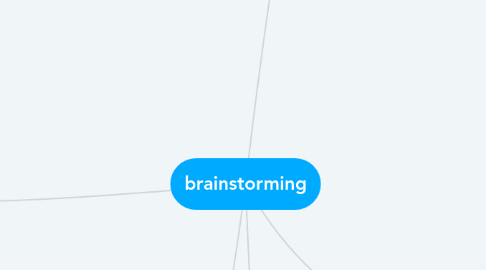
1. Mindmap
1.1. What is mind map?
1.1.1. powerful graphic technique which provides a universal key to unlock the potential of the brain
1.1.2. gives you the freedom to roam the infinite expanses of your brain.
1.1.3. applied to every aspect of life
1.2. What do you need to make mind map?
1.2.1. Blank unlined paper
1.2.2. Coloured pens and pencils
1.2.3. Your Brain
1.2.4. Your imagination
1.3. 7 steps to making a mind map
1.3.1. Start in the CENTRE of a blank page turned sideways.
1.3.2. Start in the CENTRE of a blank page turned sideways.
1.3.3. Use COLOURS throughout
1.3.4. CONNECT your MAIN BRANCHES to the central image and connect your second- and third-level branches to the first and second levels
1.3.5. Make your branches CURVED rather than straight-lined.
1.3.6. Use ONE KEYWORD PER LINE
1.4. How to make a mind map
1.4.1. Planning Your Mind Map
1.4.2. Creating a Mind Map by hand
1.4.2.1. Show the shape of the subject
1.4.2.2. Brainstorm your topic
1.4.2.3. Go straight to mapping first instead
1.4.2.4. Draw and label the first branches
1.4.2.5. Move to the next branches.
1.4.2.6. Continue branching out.
1.4.2.7. Add more or revise as a final
1.4.3. Using Mind-Mapping Software and Apps
2. ER Diagram Representation
2.1. Entity
2.1.1. Entities are represented by means of rectangles. Rectangles are named with the entity set they represent.
2.2. Atrributes
2.2.1. Attributes are the properties of entities. Attributes are represented by means of ellipses. Every ellipse represents one attribute and is directly connected to its entity
2.3. Relationship
2.3.1. Binary Relationship and Cardinality
2.3.2. Participation Constraints
3. The real meaning of Brainstorming and how do is it?
3.1. What is brainstorming
3.1.1. a group technique to create new ideas.
3.1.2. The group takes a specific problem and creates as many ideas as possible in a limited time
3.1.3. every group member to speak out all ideas that come to his/her mind, no criticism is allowed
3.1.4. encouraged to use other members’ ideas as a trigger (input) to create/associate further ideas and to combine ideas
3.2. Why and when use brainstorming?
3.2.1. brainstorming to solve all kinds of problems
3.3. How to brainstorm?
3.3.1. introduces the problem. The problem is expressed as a question.
3.3.2. all group members understand its essence.
3.3.3. visit the place where the problem occurs
3.3.4. The group meets in a half circle and starts to storm the problem.
3.3.5. Everyone just speaks out his/her ideas
3.3.6. All ideas are welcome, simple ideas, crazy ideas
3.3.7. All ideas are recorded by a note taker.
3.4. Four basic rules
3.4.1. No criticism is allowed during brainstorming
3.4.2. Quantity is important. The more ideas the better
3.4.3. Wildness is good. Crazy ideas are welcome.
3.4.4. Combining other ideas and taking another person’s ideas a step further
3.5. Evaluation of Ideas
3.5.1. Each attendant gets a packet of 5 sticky dots and places the dots on the ideas he/she likes the most.
3.6. Another way to record ideas during the meeting
3.6.1. On a whiteboard
3.6.2. On a computer where the mind map is projected to a screen visible to all group members.
3.6.3. note ideas word for word but try to use keywords or short phrases.
3.6.4. The ideas are branches that radiate from a center that contains
3.7. Why is brainstorming effective?
3.7.1. fun
3.7.2. encourages creativity and discourages criticism
3.7.3. deas by one group member are used by other group members to come up with more ideas
3.8. Can I brainstorm by my self?
3.8.1. Write the problem as a question
3.8.2. Then take about 20 to 30 minutes to write down all ideas
3.8.3. Don’t judge any idea that comes to mind. Just write.
4. How do you decide which ideas to implement?
4.1. Don't make a decision in your first brainstorming session
4.2. The roadmap
4.2.1. remove duplicate ideas.
4.2.2. Filter out obvious “No Gos.”
4.2.3. Develop ideas further.
4.2.4. Evaluate ideas
4.2.5. Decide on the ideas you want to use.
4.2.6. Implement your favorite ideas.
4.3. A set of simple criteria to remove ideas
4.3.1. Is it worth doing?
4.3.2. Can we do it?
4.3.3. Are we interested in doing it?
4.3.4. Start with a small brainstorming session to see if other criteria are relevant
4.4. evaluating ideas
4.4.1. How fast can we do it?
4.4.2. How great is the benefit? / How effective will the idea be?
4.4.3. How easy is it to do?
4.4.4. How cheap is it?
4.4.5. How risky is it?
4.4.6. How do I feel about the idea?
4.5. Multipoint Voting
4.5.1. Each member gets a packet of five sticky dots and places the dots on the ideas likes the most
4.6. decision matrix
4.6.1. Draw a decision matrix include: Header row: Names of the ideas First column: Decision criteria
4.6.2. Every participant chooses his / her favorite for each of the criteria
4.6.3. collect the sheets and populate the Decision Matrix
4.6.4. sum up the points for each idea. The winner is the idea with the most points.
5. How to brainstorming?
5.1. Create your road map
5.1.1. Look at your goal
5.1.2. Understand any requirements
5.1.3. List out and evaluate your assumptions
5.1.4. Evaluate what you have to work with
5.2. Getting inspiration
5.2.1. Do some research
5.2.2. Look at what the innovators are doing.
5.2.3. Go somewhere
5.2.4. Keep a journal next to your bed
5.2.5. Take breaks!
5.2.6. Shut out criticism
5.3. Brainstorming techniques
5.3.1. Warm up
5.3.2. Change your perspective
5.3.3. Introduce roadblocks
5.3.4. Make a mind map
5.3.5. Create idea categories
5.3.6. Write a poem, analysis, or review
5.3.7. Bring an old technique into the new age
5.3.8. Use an online idea generator.
5.3.9. Keep asking questions
5.3.10. Don't waste time
5.3.11. Do some free-writing

